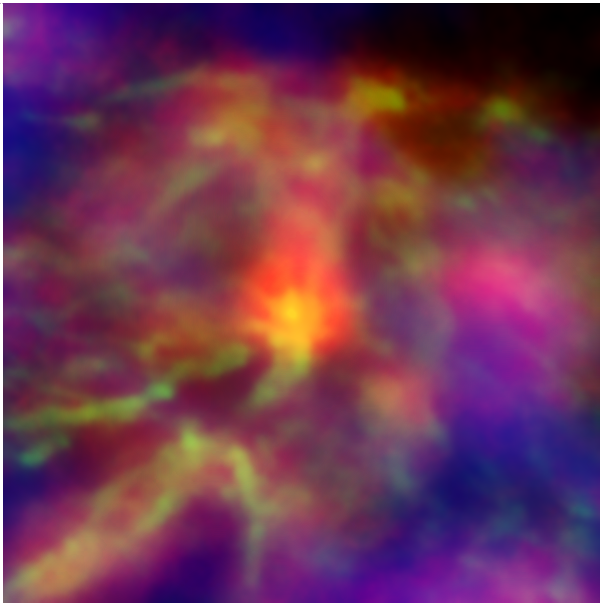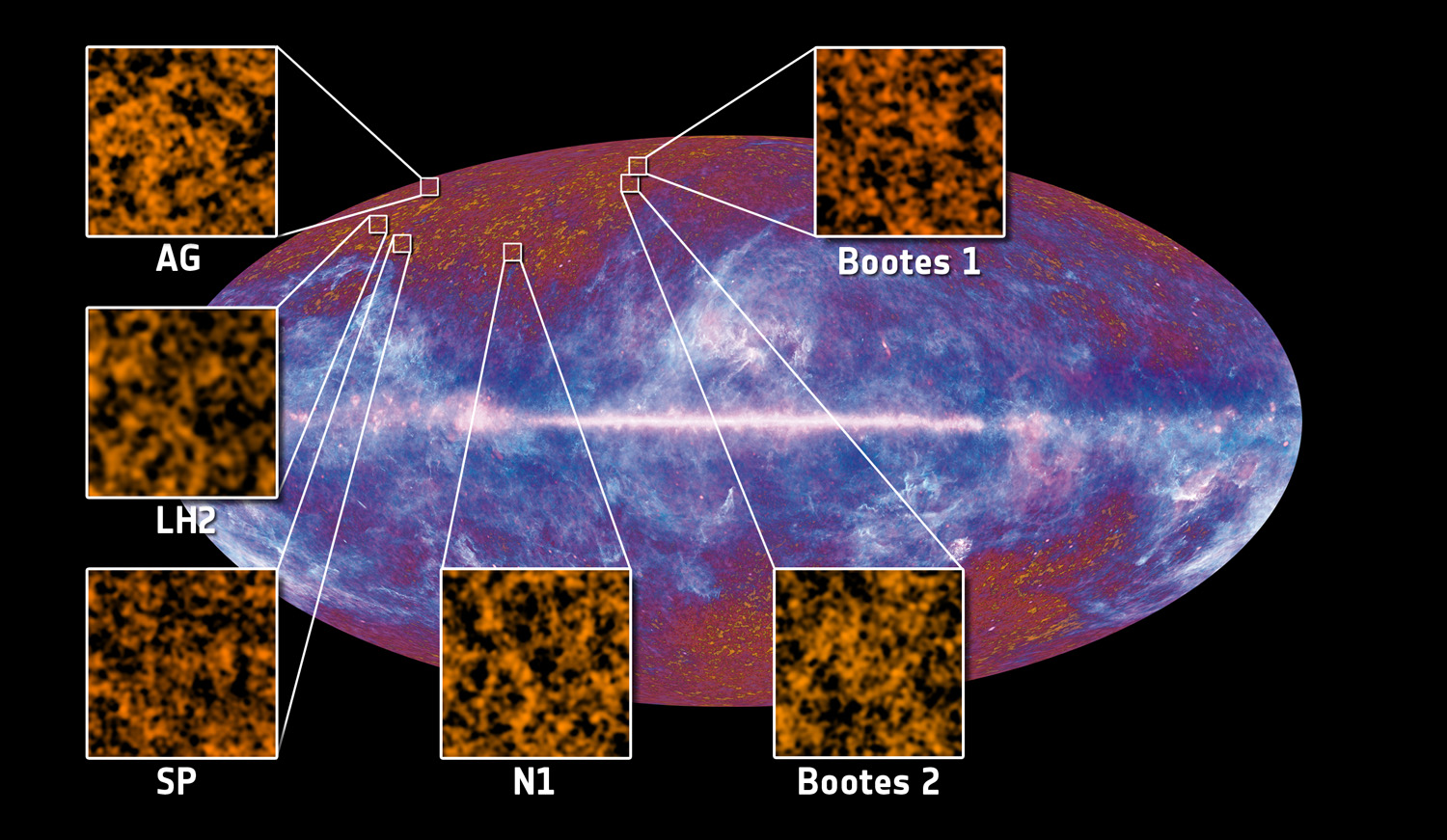Planck unveils wonders of the Universe
11 January 2011


Two of the regions studied to investigate the anomalous microwave emission, in the constellations of Perseus (left) and Ophiuchus (right). The blue shows radio waves, emitted by electrons moving in the interstellar medium. The green shows the dust seen at far-infrared and sub-millimetre wavelengths, and traces the sites of star formation. The red regions show the anomalous microwave emission. This emission is thought to be caused by tiny dust grains spinning tens of billions of times every second. Each image is around 5 degrees on a side.
Image Credits: ESA / Planck Collaboration (2011)
The first scientific results from Europe's Planck spacecraft were released at a press briefing today in Paris. The findings, focusing on the coldest objects in the Universe - both within our Galaxy and also out to the most distant reaches of space - include an exciting variety of astronomical finds, from massive galaxy clusters to new, unidentified objects. Planck is a flagship mission of the UK Space Agency, which funds the UK's involvement in both of Planck's scientific instruments. Astronomers from around the UK are now heavily involved in the operation of Planck's two scientific instruments and in understanding the images and data it is now producing.
Dr David Parker, Director of Space Science and Exploration for the UK Space Agency, said,
"We're proud to be playing a key role in this amazing discovery machine. These new results are all vital pieces of a jigsaw that could give us a full picture of the evolution of both our own cosmic backyard - the Milky Way galaxy that we live in - as well as the early history of the whole Universe."
The routine phase of Planck's mission began on 13th August 2009. The observatory's primary goal is to image the Cosmic Microwave Background, the afterglow of the Big Bang, but to do so it must look through the rest of the Universe. Whist scanning the whole sky, Planck detects emission from our own Galaxy, the Milky Way, as well as from other galaxies. It does not see stars, however, but the gas and dust from which the stars are born, and which they create when they die.
Prof. George Efstathiou, University of Cambridge and member of the Planck Science Team, said
"Planck was designed intentionally to have a wide scientific reach, extending well beyond its primary scientific goal of investigating the very first moments after the Big Bang. Planck's scientific diversity is striking in this first release of scientific results. There are new discoveries on dust and cold gas in our Galaxy, star forming regions, very distant galaxies and clusters of galaxies. These early results provide just a first glimpse of Planck's scientific potential. I expect much more to come in the next two years."

Six areas of the sky in which distant galaxies can be seen by Planck, overlaid on the Planck's first all-sky image. The emission from our own Galaxy, seen in blue and white, has to be removed before the distant population of galaxies can be seen. Each square inset image is around 100 times the size of the Full Moon.
Image Credits: ESA / Planck Collaboration (2011)
The new results include evidence for an otherwise invisible population of galaxies shrouded in dust billions of years in the past, which formed stars at rates some 10-1000 times higher than we see in our own Galaxy today (see picture, right). Measurements of this population had never been made at these wavelengths before. In order to see it properly, contaminating emission from a whole host of foreground sources must first be removed.
Today, an important step towards removing this contamination was also announced. The 'anomalous microwave emission' is a diffuse glow most strongly associated with the dense, dusty regions of our Galaxy, but its origin has been a puzzle for decades.
However, data collected by Planck confirm the theory that it is coming from dust grains spun up by collisions with either fast-moving atoms or packets of ultraviolet light. This new understanding helps to remove this local microwave 'fog' from the Planck data with greater precision, leaving the cosmic microwave background untouched (see picture, top).
Dr Clive Dickinson, University of Manchester, UK, said
"We are now becoming rather confident that the anomalous emission is due to nano-scale spinning grains of dust, which rotate up to ten thousand million times per second. This is a great result made possible by the exceptional quality of the Planck data."
One of the advantages of Planck's broad wavelength coverage is that it can detect very cold dust both within our Galaxy and beyond. Cold clumps of dust in our Galaxy, of which Planck has found over 900, represent the first stages of starbirth.
Additionally, a survey of around 500 galaxies within a few billion light years has shown that some of them contain much more cold dust than previously thought.
Dr David Clements, Imperial College London, said
"Planck will help us to build a ladder connecting our Milky Way to the faint, distant galaxies and uncovering the evolution of dusty, star forming galaxies throughout cosmic history."
Among the many other results presented today, Planck has also collected new data on clusters of galaxies - the largest structures in the Universe, each containing thousands of galaxies. These show up in the Planck data as compact silhouettes against the cosmic microwave background. By surveying the whole sky, Planck stands the best chance of finding the most massive examples of these clusters. They are rare and their number is a sensitive probe of the kind of Universe we live in, how fast it is expanding, and how much matter it contains.
The Planck mission has been in development for over 15 years, leading up to its launch in May 2009.
Dr Althea Wilkinson, University of Manchester, said
"We could hardly imagine this point when we were building amplifiers for the Low Frequency Instrument at Jodrell Bank over 5 years ago. It is fantastic to have reached the stage where we see real science emerging."Prof. Peter Ade, Cardiff University, who works on the High Frequency Instrument, added:
"Seeing these excellent results gives a glimpse of the legacy the Planck mission will provide in terms of our understanding of the Universe."
Planck continues to survey the Universe. Its next data release is scheduled for January 2013 and will reveal the cosmic microwave background in unprecedented detail, the opening act of the cosmic drama, a picture of the beginning of everything.
Editors notes:
Many of the new results are from Planck's Early Release Compact Source Catalogue. Drawn from Planck's continuing survey of the entire sky, the catalogue contains thousands of very cold, individual sources which the scientific community is now free to explore.
ESA's Planck mission maps the sky in nine frequencies using two state-of-the-art instruments, designed to produce high-sensitivity, multi-frequency measurements of the diffuse sky radiation: the High Frequency Instrument (HFI) includes the frequency bands 100-857 GHz (wavelengths of 3mm to 0.35mm), and the Low Frequency Instrument (LFI) includes the frequency bands 30-70 GHz (wavelengths of 10mm to 4mm).
The first scientific results to emerge from the mission, based on the scans gathered during Planck's first all-sky survey, between 13 August 2009 and 6 June 2010, are being presented this week (10-14 January 2011) at the conference "The Millimeter and Submillimeter Sky in the Planck Mission Era" held in Paris, France.
The Planck Scientific Collaboration consists of all the scientists who have contributed to the development of the Planck mission, and who participate in the scientific exploitation of the Planck data during the proprietary period, which nominally ends with the release of the scientific products to the community 3.5 yr after launch, i.e. in January 2013. These scientists are members of one or more of four consortia: the LFI Consortium, the HFI Consortium, the DK-Planck Consortium, and ESA's Planck Science Office.
UK role in Planck
A number of UK institutes and companies form part of the consortium building the two focal plane instruments, the HFI (High Frequency Instrument) and LFI (Low Frequency Instrument). The Jodrell Bank Observatory at The University of Manchester has produced critical elements of the LFI receiver modules. Cardiff University played a major role in the design, manufacture and calibration of the focal plane of the High Frequency Instrument. STFC Rutherford Appleton Laboratory and west-country space company SEA Ltd. helped build HFI, including its super-cool refrigerator. Various UK research groups including Imperial College London and University of Cambridge form the London Planck Analysis Centre and Cambridge Planck Analysis Centre. All the university groups are now involved in the operation, calibration, analysis and simulation of the Planck data. More information can be found in the Planck briefing document. UK funding for the Planck mission is supplied by the UK Space Agency.
Jodrell Bank's role in Planck
Jodrell Bank Centre for Astrophysics (JBCA) is directly involved with the two lowest frequencies of the Low Frequency Instrument, the 30 and 44 GHz radiometers. These have 4 and 6 detectors respectively, operating at 20K (-253.15°C or -423.67°F). The resolution on the sky is 33 and 27 arc minutes, and the sensitivity 1.6 and 2.4 micro K (over 12 months). The cryogenic low noise amplifiers which are the heart of the radiometers were developed at Jodrell Bank, with help from the National Radio Astronomy Observatory in Virginia, USA.
Dr B. Maffei and Dr G. Pisano are involved in the other focal instrument, the HFI. First at Cardiff University and now at the University of Manchester, they have played a major role in the design, development and calibration of the Focal Plane Unit, in particular the cold optics, in collaboration with the Institut d'Astrophysique Spatiale - France, Maynooth University - Ireland and JPL/Caltech - USA.
The work to understand the Galactic emission seen by Planck is being co-led from Jodrell Bank by Emeritus Professor Rod Davies. A number of projects are led by Jodrell Bank scientists, including Professor Richard Davis and Dr Clive Dickinson. Each of the 14 projects focusses on one aspect of the Galaxy as seen by Planck, including the electrons that gyrate in the Galactic magnetic field, the ionized gas that pervades the interstellar medium and the dust grains that emit across the entire frequency range that Planck is sensitive to. Jodrell Bank is also leading the calibration and identifying systematics in the LFI data.
Further information
For more information, please see:Contacts
For more information please contact
Dr Althea Wilkinson,
Jodrell Bank Centre for Astrophysics,
Alan Turing Building,
The University of Manchester,
Oxford Road,
Manchester M13 9PL
althea.wilkinson [@] manchester.ac.uk
+44 (0)161 275 4184.
Dr Chris North,
School of Physics and Astronomy,
Cardiff University,
Queen's Buildings,
The Parade,
Cardiff CF42 3AA
chris.north[@]astro.cf.ac.uk
+44 (0)129 208 70537
Julia Short, Press Officer, STFC and UKSA
Email: Julia.short [@] stfc.ac.uk
Tel: +44 (0)1793 442 012
Jan Tauber, Planck Project Scientist
Science and Robotic Exploration Directorate
European Space Agency, The Netherlands
jtauber[@]rssd.esa.int
+31 71 565 5342.


